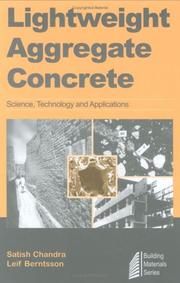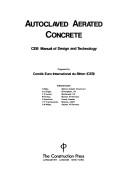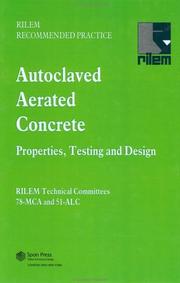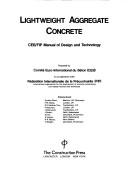| Listing 1 - 10 of 11 | << page >> |
Sort by
|
Book
ISBN: 0853340099 Year: 1968 Publisher: London CR books
Abstract | Keywords | Export | Availability | Bookmark
 Loading...
Loading...Choose an application
- Reference Manager
- EndNote
- RefWorks (Direct export to RefWorks)
Concrete construction --- Lightweight concrete --- Cellular concrete --- Concrete, Lightweight --- No-fines concrete --- Pervious concrete --- Porous concrete --- Concrete --- Building, Concrete --- Concrete building --- Construction, Concrete --- Building --- Concrete construction. --- Lightweight concrete.

ISBN: 1591243882 9781591243885 9780815518150 0815518153 9780815518204 081551820X 0815514867 9780815514862 1282011154 9781282011151 9786612011160 1282011162 Year: 2003 Publisher: Norwich, N.J. : Noyes Publications,
Abstract | Keywords | Export | Availability | Bookmark
 Loading...
Loading...Choose an application
- Reference Manager
- EndNote
- RefWorks (Direct export to RefWorks)
In spite of the increasing use and demand for lightweight aggregate concrete (LWAC), there is still a lack of adequate explanations to understand the mechanisms responsible for the strength and durability properties of LWAC. This book is written to give an overall picture of LWAC, from the historical background, aggregate production, proportioning and production of concrete, to applications in structures. Physical properties and chemical durability are described in detail. The physical properties include density, strength, shrinkage, and elasticity. Chemical durability includes resistance to a
Engineering --- Civil Engineering --- Lightweight concrete. --- Aggregates (Building materials) --- Mineral aggregates --- Building materials --- Cellular concrete --- Concrete, Lightweight --- No-fines concrete --- Pervious concrete --- Porous concrete --- Concrete

ISBN: 0904406768 9780904406764 Year: 1978 Publisher: Lancaster, Eng. ; New York : The Construction Press,
Abstract | Keywords | Export | Availability | Bookmark
 Loading...
Loading...Choose an application
- Reference Manager
- EndNote
- RefWorks (Direct export to RefWorks)
Lightweight concrete --- 691.32 --- #KVIV --- Cellular concrete --- Concrete, Lightweight --- No-fines concrete --- Pervious concrete --- Porous concrete --- Concrete --- Concrete. Concrete buiding elements --- 691.32 Concrete. Concrete buiding elements --- Concrete. --- Béton. --- Autoclaves. --- Slabs. --- Dalles (construction)
Periodical
Abstract | Keywords | Export | Availability | Bookmark
 Loading...
Loading...Choose an application
- Reference Manager
- EndNote
- RefWorks (Direct export to RefWorks)
Composite materials --- Cement composites --- Lightweight concrete --- Cement composites. --- Composite materials. --- Lightweight concrete. --- Cementitious composites --- Cellular concrete --- Concrete, Lightweight --- No-fines concrete --- Pervious concrete --- Porous concrete --- Composites (Materials) --- Multiphase materials --- Reinforced solids --- Solids, Reinforced --- Two phase materials --- Cement --- Concrete --- Materials --- Materials Science
Periodical
Abstract | Keywords | Export | Availability | Bookmark
 Loading...
Loading...Choose an application
- Reference Manager
- EndNote
- RefWorks (Direct export to RefWorks)
"This journal is designed to reflect current developments and advances being made in the general field of cement-concrete composites technology and in the production, use, and performance of cement-based construction materials in general. The word cement is interpreted here in a wide sense to include not only Portland cement but also other matrices such as composite cements, resins, polymers and sulphur. The journal will therefore cover a wide range of composite materials such as fibre cement/concrete composites, polymer cement composites, polymer impregnated composites ferrocement resin concretes, lightweight, wood composites, use of waste material, composite cements, adhesion bonding and fibre reinforced plastics as applied to construction, and material and structural composite systems."
Lightweight concrete --- Composite materials --- Concrete --- Cement composites --- Composite reinforced concrete --- Composite-reinforced concrete --- Composites de ciment --- Béton --- Composites --- Béton léger --- Périodiques. --- Cellular concrete --- Concrete, Lightweight --- No-fines concrete --- Pervious concrete --- Porous concrete --- Cementitious composites --- Concrete, Composite-reinforced --- Reinforced concrete, Composite --- -Périodiques. --- Cement --- -Reinforced concrete --- Reinforced concrete --- -Composite-reinforced concrete

Abstract | Keywords | Export | Availability | Bookmark
 Loading...
Loading...Choose an application
- Reference Manager
- EndNote
- RefWorks (Direct export to RefWorks)
Lightweight concrete --- #KVIV:BB --- 691.3 --- 624.012.4 --- Cellular concrete --- Concrete, Lightweight --- No-fines concrete --- Pervious concrete --- Porous concrete --- Concrete --- Artificial stone. Concrete. Various agglomerates --- Structures in concrete, in-situ concrete (ordinary concrete), mass concrete --- Lightweight concrete. --- 624.012.4 Structures in concrete, in-situ concrete (ordinary concrete), mass concrete --- 691.3 Artificial stone. Concrete. Various agglomerates

ISBN: 0904406245 9780904406245 Year: 1977 Publisher: Lancaster, Eng. ; New York : The Construction Press,
Abstract | Keywords | Export | Availability | Bookmark
 Loading...
Loading...Choose an application
- Reference Manager
- EndNote
- RefWorks (Direct export to RefWorks)
Lightweight concrete --- Aggregates (Building materials) --- Handbooks, manuals, etc --- 691.327 --- -Aggregates (Building materials) --- -Mineral aggregates --- Building materials --- Cellular concrete --- Concrete, Lightweight --- No-fines concrete --- Pervious concrete --- Porous concrete --- Concrete --- Unreinforced concrete --- Handbooks, manuals, etc. --- -Unreinforced concrete --- 691.327 Unreinforced concrete --- -691.327 Unreinforced concrete --- Mineral aggregates --- Mixing. --- Set theory. --- Lightweight concrete - Handbooks, manuals, etc --- Aggregates (Building materials) - Handbooks, manuals, etc --- Lightweight concrete. --- Béton léger. --- Granulats.
Book
Year: 2022 Publisher: Basel MDPI - Multidisciplinary Digital Publishing Institute
Abstract | Keywords | Export | Availability | Bookmark
 Loading...
Loading...Choose an application
- Reference Manager
- EndNote
- RefWorks (Direct export to RefWorks)
Thanks to the progress made in materials research and to the introduction of innovative manufacturing technologies, a wide range of sound-absorbing elements are currently available to adjust the acoustic features of an environment. Nowadays, performance is only one of the required specifications, together with environmental compatibility, longevity, and affordable cost. This book collects the most recent advances in the broad-spectrum characterization of sound-absorbing materials used in civil, industrial, and tertiary applications, by means of experimental, numerical, or theoretical studies.
Technology: general issues --- History of engineering & technology --- hollow perforated spherical structure with extended tubes --- low frequency sound absorption --- melamine foam --- wideband sound absorber --- speech clarity --- bass ratio --- sound absorption --- reverberation time --- acoustics --- aerogels --- modeling --- fiber --- porous materials --- acoustic measurements --- sound absorption coefficient --- cement-based materials --- building materials --- pervious concrete --- acoustic concrete --- household end-of-life materials --- building retrofitting --- sound insulation --- vulnerable houses --- circular economy --- egg-box --- cardboard --- textile waste --- reuse --- shunted loudspeaker --- optimal sound absorption --- fully exhaustive method --- steel industry by-products --- sound reduction index --- granular materials --- inverse method --- cross laminated timber --- impact noise --- rubber ball --- sustainable --- timber --- perforated plate --- stepwise apertures --- low frequency --- membranes --- measurement method --- transmission loss --- simulations --- experiment --- scattering effect --- diffusion coefficient --- reflecting panels --- QRD --- ISO 17497 --- hollow perforated spherical structure with extended tubes --- low frequency sound absorption --- melamine foam --- wideband sound absorber --- speech clarity --- bass ratio --- sound absorption --- reverberation time --- acoustics --- aerogels --- modeling --- fiber --- porous materials --- acoustic measurements --- sound absorption coefficient --- cement-based materials --- building materials --- pervious concrete --- acoustic concrete --- household end-of-life materials --- building retrofitting --- sound insulation --- vulnerable houses --- circular economy --- egg-box --- cardboard --- textile waste --- reuse --- shunted loudspeaker --- optimal sound absorption --- fully exhaustive method --- steel industry by-products --- sound reduction index --- granular materials --- inverse method --- cross laminated timber --- impact noise --- rubber ball --- sustainable --- timber --- perforated plate --- stepwise apertures --- low frequency --- membranes --- measurement method --- transmission loss --- simulations --- experiment --- scattering effect --- diffusion coefficient --- reflecting panels --- QRD --- ISO 17497
Book
Year: 2022 Publisher: Basel MDPI - Multidisciplinary Digital Publishing Institute
Abstract | Keywords | Export | Availability | Bookmark
 Loading...
Loading...Choose an application
- Reference Manager
- EndNote
- RefWorks (Direct export to RefWorks)
Thanks to the progress made in materials research and to the introduction of innovative manufacturing technologies, a wide range of sound-absorbing elements are currently available to adjust the acoustic features of an environment. Nowadays, performance is only one of the required specifications, together with environmental compatibility, longevity, and affordable cost. This book collects the most recent advances in the broad-spectrum characterization of sound-absorbing materials used in civil, industrial, and tertiary applications, by means of experimental, numerical, or theoretical studies.
hollow perforated spherical structure with extended tubes --- low frequency sound absorption --- melamine foam --- wideband sound absorber --- speech clarity --- bass ratio --- sound absorption --- reverberation time --- acoustics --- aerogels --- modeling --- fiber --- porous materials --- acoustic measurements --- sound absorption coefficient --- cement-based materials --- building materials --- pervious concrete --- acoustic concrete --- household end-of-life materials --- building retrofitting --- sound insulation --- vulnerable houses --- circular economy --- egg-box --- cardboard --- textile waste --- reuse --- shunted loudspeaker --- optimal sound absorption --- fully exhaustive method --- steel industry by-products --- sound reduction index --- granular materials --- inverse method --- cross laminated timber --- impact noise --- rubber ball --- sustainable --- timber --- perforated plate --- stepwise apertures --- low frequency --- membranes --- measurement method --- transmission loss --- simulations --- experiment --- scattering effect --- diffusion coefficient --- reflecting panels --- QRD --- ISO 17497 --- n/a
Book
ISBN: 3039214748 303921473X Year: 2019 Publisher: MDPI - Multidisciplinary Digital Publishing Institute
Abstract | Keywords | Export | Availability | Bookmark
 Loading...
Loading...Choose an application
- Reference Manager
- EndNote
- RefWorks (Direct export to RefWorks)
The fluid flow in fracture porous media plays a significant role in the assessment of deep underground reservoirs, such as through CO2 sequestration, enhanced oil recovery, and geothermal energy development. Many methods have been employed—from laboratory experimentation to theoretical analysis and numerical simulations—and allowed for many useful conclusions. This Special Issue aims to report on the current advances related to this topic. This collection of 58 papers represents a wide variety of topics, including on granite permeability investigation, grouting, coal mining, roadway, and concrete, to name but a few. We sincerely hope that the papers published in this Special Issue will be an invaluable resource for our readers.
deformation feature --- minerals --- microstructure --- mixing --- permeability --- gas concentration --- water–rock interaction --- loose gangue backfill material --- unified pipe-network method --- fracture --- roof-cutting resistance --- crack --- similar-material --- movable fluid --- gob-side entry retaining (GER) --- rock-soil mechanics --- bed separation --- orthogonal tests --- charge separation --- water soaked height --- fluid flow in reclaimed soil --- laboratory experiment --- longwall mining --- grading broken gangue --- MIP --- elastic modulus --- effective stress --- permeability coefficient --- mixer --- naturally fracture --- SEM --- microstructure characteristics --- artificial joint rock --- fractured rock --- strata movement --- conservative solute --- particle velocity --- dry-wet cycles --- hydraulic fractures --- numerical calculation --- mechanical behaviors --- normalized conductivity-influence function --- fractured porous rock mass --- PPCZ --- segmented grouting --- non-aqueous phase liquid --- intelligent torque rheometer --- numerical analysis --- temperature --- unsaturated soil --- uniaxial compressive strength --- mine shaft --- coalbed methane (CBM) --- nonlinear flow in fractured porous media --- similar simulation --- forecasting --- tight sandstones --- oriented perforation --- hydro-mechanical coupling --- constant normal stiffness conditions --- cohesive soils --- layered progressive grouting --- chemical grouts --- grain size of sand --- Darcy’s law --- soft coal masses --- hydro-power --- cyclic heating and cooling --- cohesive element method --- cement-based paste discharge --- tectonically deformed coal --- split grouting --- fault water inrush --- filtration effects --- T-stress --- particle flow modeling --- new cementitious material --- strength --- stabilization --- fractured porous medium --- brine concentration --- initial water contained in sand --- XRD --- fracture criteria --- hydraulic conductivity --- roadway deformation --- backfill mining --- adsorption/desorption properties --- pore pressure --- roughness --- cement–silicate grout --- compressive stress --- discrete element method --- dynamic characteristics --- strain-based percolation model --- thermal-hydrological-chemical interactions --- pore distribution characteristics --- transversely isotropic rocks --- nitric acid modification --- disaster-causing mechanism --- CH4 seepage --- crack distribution characteristics --- micro-CT --- relief excavation --- Darcy flow --- hydraulic fracturing --- mixed-form formulation --- propagation --- scanning electron microscope (SEM) images --- propagation pattern --- consolidation process --- rheological deformation --- gas adsorption --- soft filling medium --- ground pressure --- orthogonal ratio test --- rock fracture --- coal seams --- high-steep slope --- interface --- orthogonal test --- stress interference --- physical and mechanical parameters --- fracture propagation --- fluid–solid coupling theory --- coupling model --- surface characteristics --- numerical manifold method --- gas --- lignite --- water inrush prevention --- coupled THM model --- hard and thick magmatic rocks --- Ordos Basin --- porosity --- damage mechanics --- seepage --- degradation mechanism --- high temperature --- visualization system --- bentonite-sand mixtures --- contamination --- conductivity-influence function --- water-rock interaction --- deterioration --- seepage pressure --- glutenite --- adhesion efficiency --- mechanical behavior transition --- bedding plane orientation --- n/a --- enhanced gas recovery --- debris-resisting barriers --- reinforcement mechanism --- on-site monitoring --- geophysical prospecting --- cyclic wetting-drying --- scoops3D --- semi-analytical solution --- enhanced permeability --- management period --- seepage control --- deformation --- Yellow River Embankment --- impeded drainage boundary --- rheological test --- circular closed reservoir --- grout penetration --- viscoelastic fluid --- coal-like material --- paste-like slurry --- floor failure depth --- supercritical CO2 --- gravel --- numerical model --- fractal --- gas-bearing coal --- shear-flow coupled test --- rheological limit strain --- CO2 flooding --- flotation --- goaf --- slope stability --- damage --- coal and gas outburst --- hydraulic fracture --- anisotropy --- high-order --- effluents --- FLAC --- limestone roof --- sandstone --- TG/DTG --- Xinjiang --- two-phase flow --- model experiment --- coal particle --- volumetric strain --- failure mode --- land reclamation --- sandstone and mudstone particles --- contiguous seams --- CO2 geological storage --- numerical simulation --- geogrid --- stress relief --- optimum proportioning --- roadside backfill body (RBB) --- pervious concrete --- mudstone --- hydraulic fracture network --- grouted sand --- fractal pore characteristics --- refraction law --- segmented rheological model --- ductile failure --- heterogeneity --- flow law --- fracture closure --- coal measures sandstone --- tight sandstone gas reservoirs --- gob behaviors --- water-dripping roadway --- creep characteristics --- internal erosion --- warning levels of fault water inrush --- hydraulic aperture --- bolt support --- discontinuous natural fracture --- microscopic morphology --- critical hydraulic gradient --- mixed mode fracture resistance --- differential settlement --- alternate strata --- finite element method --- crushing ratio --- chloride --- glauberite cavern for storing oil & --- macroscopic mechanical behaviors --- collision angle --- adsorption performance --- failure mechanism --- mechanical properties --- transmissivity --- damage evolution --- gas fracturing --- multitude parameters --- deviatoric stress --- Jiaohe --- coal --- soil properties --- acoustic emission --- pore structure --- grouting experiment --- concrete --- confining pressures --- green mining --- gas drainage --- fluid viscosity --- compression deformation --- Unsaturation --- adsorption–desorption --- seepage-creep --- constitutive model --- soil particle size --- Pseudo Steady-State (PPS) constant --- soil–structure interface --- debris flow --- fracture grouting --- initial settlement position --- regression equation --- electrical potential --- secondary fracture --- surrounding rock --- solid backfill coal mining --- time variation --- excess pore-pressures --- finite-conductivity fracture --- permeability characteristics --- rainfall-unstable soil coupling mechanism(R-USCM) --- shaft lining --- Darcy's law --- cement-silicate grout --- fluid-solid coupling theory --- adsorption-desorption --- soil-structure interface
| Listing 1 - 10 of 11 | << page >> |
Sort by
|

 Search
Search Feedback
Feedback About UniCat
About UniCat  Help
Help News
News